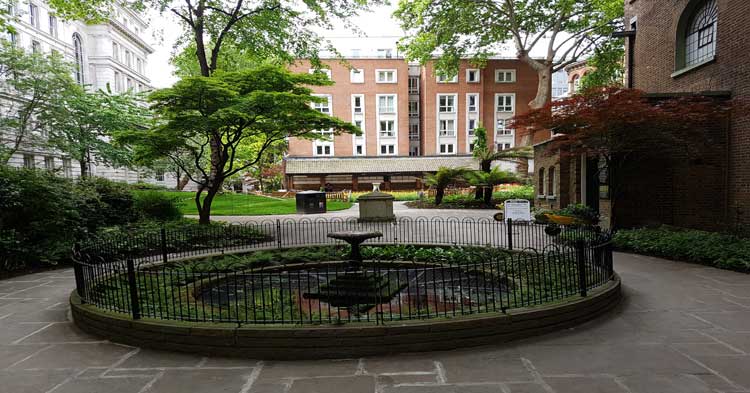
Postman's Park, one of the largest gardens in the City of London, occupies an amalgamation of three City of London burial grounds - Christchurch, Greyfriars, St Leonard, Foster Lane, and St Botolph, Aldersgate, the latter of which the park stands alongside.
The church of St Botolph, Aldersgate, also referred to as "St Botolph Without Aldersgate", on account of its being situated directly outside the City's Aldersgate, is - in my opinion at least - one of London's loveliest churches and it is well worth a visit.
Botolph, or Botwulf to use his correct designation, was a 7th-century East Anglian saint, who was the patron saint of travellers before his popularity in the travelling department was usurped by St, Christopher.
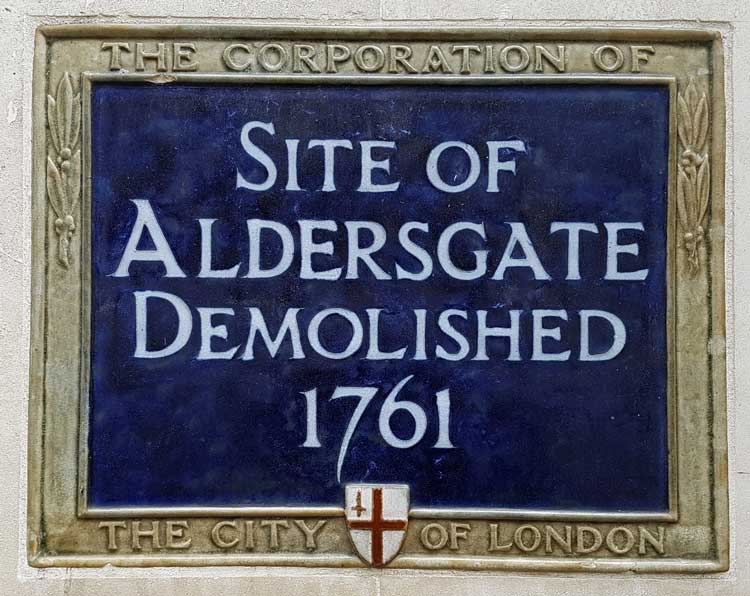
As a consequence of his former usefulness to those embarking on journeys, there were, in fact, four churches - St Botolph, Aldersgate, St Botolph, Bishopsgate, St Botolph, Aldgate and St Botolph, Billingsgate - dedicated to him in medieval London, all of which were situated next to the City gates.
The Great Fire of London (C. 1666) put paid to St Botolph's Billingsgate, but the other three, albeit they have been rebuilt several times, are still going strong.
However, the gates alongside which they once stood have long since disappeared and are, nowadays, only commemorated on information plaques close to their original sites.
There has been a church here since 1291, so, as a site of worship, St Botolph, Aldersgate most certainly has a long and distinguished heritage.
The medieval church managed to survive the Great Fire of London in 1666.
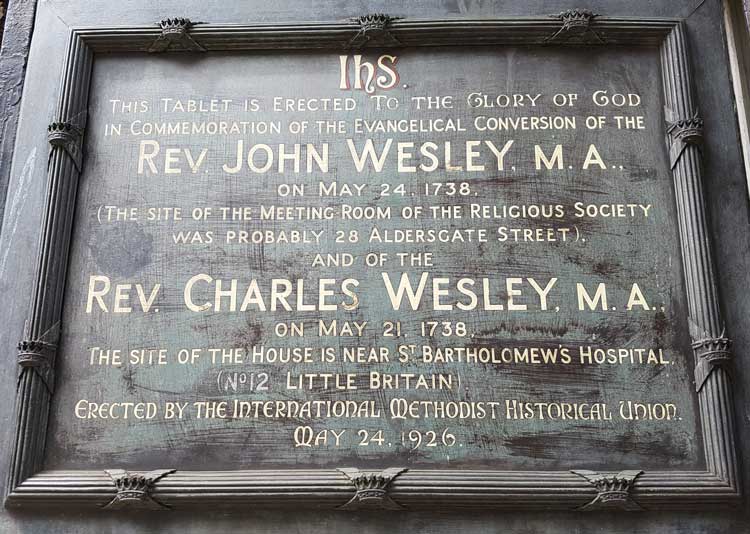
Unfortunately, it did not prove as adept at dodging the ravages of time and, by the mid-18th century, the building was in a sorry, not to say dangerous, state, and, as a consequence, it was demolished and rebuilt in its present form between 1788 and 1791.
Religiously speaking (if one can, indeed, speak religiously), the parish that the church serves is important in that it was within its boundaries that both John and Charles Wesley underwent their evangelical conversions, events that are commemorated on plaques on the outer railings and walls of Postman's Park.
An aspect of Postman's Park that many visitors comment on is the number of gravestones that hide amidst the foliage, or which are grouped against various of the walls.

These are leftovers from the former burial grounds, the sites of which Postman's Park now occupies.
By the 19th century, the dead of London far outnumbered the living of the City, and evidence of the deceased was abhorrently apparent in the City's overcrowded churchyards.
There was a massive shortage of available burial space and, in consequence, graves would be used several times over. This presented its own problem, in that it proved nigh on impossible to dig a grave without disturbing the previous occupants of it (or at least their remains).
The solution was to lay bodies on top of each other, separated by a layer of soil.
The effect of this policy was to raise the levels of the City's churchyards so that, as Dickens put in in Our Mutual Friend, the dead were, "... conveniently and healthily elevated above the level of the living..."
With the onset of the cholera epidemics from the 1830's, public concern about the health of the City led to the passing of the 1851 Metropolitan Burials Act which forbade any further burials in the built-up parts of London.
Burials instead took place in outlying cemeteries such as Highgate and Kensal Green.
In 1858, the churchwardens of St. Botolph, Aldersgate, announced that they intended to "..plant, pave, or cover over the churchyard and burial-ground."
As for concerned citizens who might have relatives resting therein, the advice was simple:-
"Persons having relatives interred in the said churchyard or burial-ground will be permitted (under certain regulations) to remove and inter the remains of such relatives in any burial-ground or cemetery, without the city.
Persons also, to the memory of whose relatives any tomb, monument, or inscription may have been erected therein, may (under the like regulations) cause such tomb or grave-stones to be removed and taken away; but such removal, in either case, must be at the expense of the persons causing the same to be done.
Applications for either of the above purposes must be made, in writing, on or before Monday, the 20th day of December, 1858."
Unfortunately, clearing the remains of all those former parishioners proved an onerous and time consuming task, and it took them until 1880 to complete it.
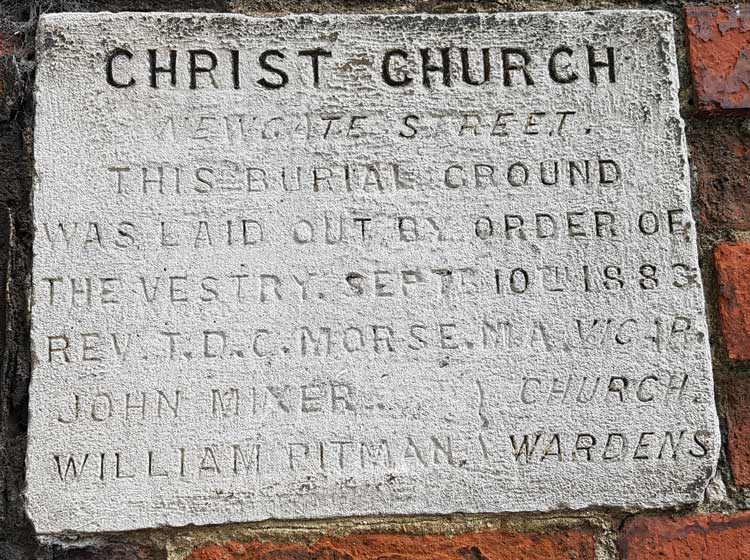
But, finally, the clearance and the landscaping were both completed and, on the 28th October 1880,the park finally opened to the public.
As it happened, in 1829, the General Post Office had moved into a building on nearby St Martin Le Grand and, whilst work on the new park was going on, the post office went through a massive expansion, which saw it take over much of the surrounding area.
When the new park opened in 1880, it quickly became a popular leisure time resort for the post office workers and, as a result, the park soon became known as "Postman's Park."
However, in the late 1890's, the park found itself under threat from the ominous spectre of the Victorian property developers who began casting covetous gazes towards what they viewed as a prime site for building development.
The northern section of the park had, from the early 1890's, come under the jurisdiction of the newly formed City Parochial Foundation; and, in 1896, they fenced it off and announced they would consider offers from interested builders who might like to develop the land.
Following howls of protest at the potential loss of one of the City's few open space, the Foundation announced that it would be happy to sell the land to St Botolph's for £12,000.
Despite a slow start, the campaign soon won the support of the Metropolitan Public Gardens Association, and soon contributions were coming in from local businesses, concerned citizens, and both the London County Council and the corporation of the City of London.
On 14th November 1896, Basil Holmes, The Secretary of the Metropolitan Public Gardens Association wrote to the Evening Standard to remind firms in the locality that prompt action was required:-
"Sir, - You are aware of the appeal which is being made to purchase the strip of land adjoining what is known as "The Postman's Park."
A fortnight, back a collecting paper was left with all the large City firms, asking them to forward any subscriptions by Monday, the 16th inst.
We are anxious to remind those firms who are collecting for this object that they should forward any amounts they may have obtained at the earliest possible moment to the Earl of Meath. Metropolitan Public Gardens Association, 83, Lancaster-gate, W.
You will be pleased to hear that there is now only about four thousand pounds required to complete time purchase price of twelve thousand pounds.
I am, Sir, your obedient servant.
BASIL HOLMES, Secretary,
The Metropolitan Public Gardens Association.
It was around this time that the first suggestions were being mooted that the park would make the ideal location for a memorial to ordinary men, women and children - humble heroes - who had sacrificed their lives endeavouring to save the lives of others.
The chief proponents of a scheme to remember these everyday, ordinary heroes, were the artist, George Frederic Watts (1817 - 1904) and his wife, Mary (1849 - 1938).
A friend of Watts had suggested to the then vicar of St Botolph's, Henry Reginald Gamble (1859 - 1931) that the new park would make a fitting setting for the Watts' proposed memorial.
Watts was approached, and he agreed to construct the memorial at his own expense.
His initial idea was to build a covered cloister around three sides of a quadrangle, with the roof supported on stone or timber columns.
However, The Metropolitan Public Gardens Association, complained that they had not been consulted about the scheme, and, following a period of delicate negotiating, the initial proposal was toned down in favour the 50-foot (15 m) long and 9-foot (2.7 m) tall wooden loggia with a tiled roof, which greets visitors to Postman's Park today.

With the necessary funds to purchase the land having been acquired, and the dispute over the style of memorial settled, work began on both a reunified Postman's Park and the Watts Memorial to Heroic Self Sacrifice in 1899.
As the new century was ushered in, the works were completed and both the park and the memorial opened to the public on the 30th July 1900.
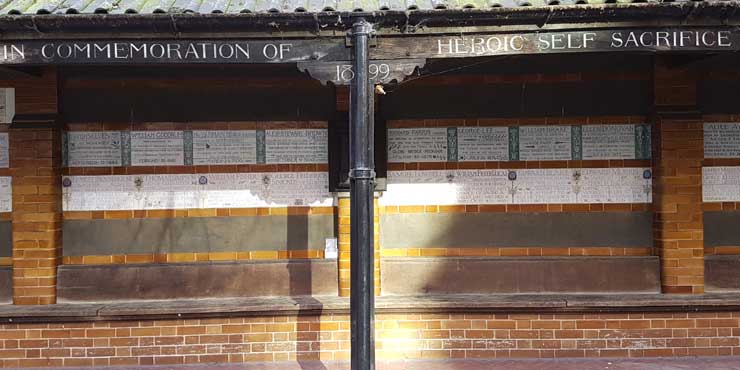
The memorials featured on the memorial wall in Postman's Park are as fascinating as they are poignant,
In the pages that follow you will be able to read the stories of every person remembered thereon.
I have begun with a history of how Watts came to create the memorial and of his battle to get it set up and sited.
There then follows a key to everyone of the memorials, in which you will be able to click on the name and be taken through to the press accounts of each one of the acts of heroic self sacrifice.
You can, if you wish, visit the park and use this guide to read about each of the Postman's Park memorials as you stand in front of them.